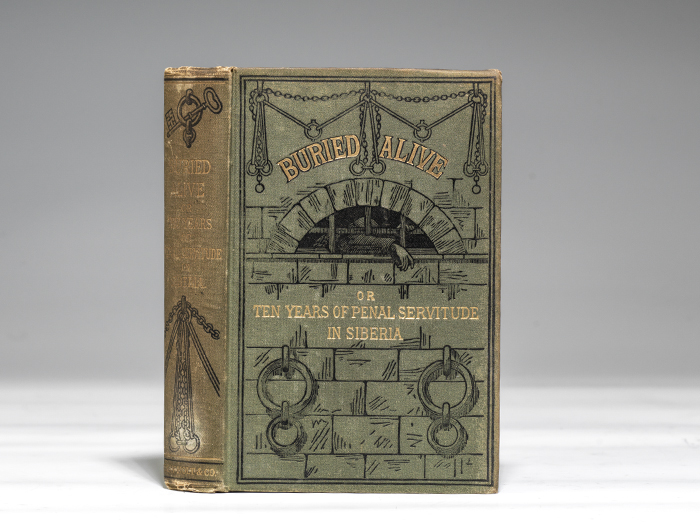
"THE FINEST WORK IN ALL OF MODERN RUSSIAN LITERATURE" (TOLSTOY): DOSTOEVSKY’S SEMI-AUTOBIOGRAPHICAL THE HOUSE OF THE DEAD, 1881 FIRST AMERICAN EDITION—"THE FIRST NOVEL ABOUT RUSSIAN PRISONS IN SIBERIA," AND THE FIRST OF DOSTOEVSKY'S WORKS TO BE TRANSLATED INTO ENGLISH
DOSTOEVSKY, Fyodor. Buried Alive. Or Ten Years of Penal Servitude in Siberia [The House of the Dead]. New York: Henry Holt, 1881. Octavo, original pictorial gray-green cloth. Housed in a custom clamshell box. $7200.
Rare first American edition of one of Dostoevsky’s most famous and most universally recognized works, The House of the Dead, a semi-autobiographical novel praised by Tolstoy as "the finest work in all of modern Russian literature"—also "the first novel about Russian prisons in Siberia"—published here under the title "Buried Alive." This was the first American publication of any book by Dostoevsky (spelled "Fedor Dostoyeffsky" on the title page), issued posthumously in the year of his death.
In 1849 Dostoevsky and fellow members of an underground group were arrested and sentenced to death. It was only after they stood in front of the firing squad that they learned the sentence had been commuted to hard labor in Siberia. "The physical and mental trauma of this near execution would never leave Dostoevsky" (Stone, 51). His four-year imprisonment in a maximum-security prison in Omsk became the basis for this semi-autobiographical work, titled in Russian, Zapiski iz mertvogo doma (The House of the Dead). Written after his release from prison, The House of the Dead was "The first novel about Russian prisons in Siberia… [it] bore witness, for the first time to the civilized world, to all the suffering of Russian prisoners" (Sekirin, Dostoevsky Archive, 109-110). Dostoevsky describes here, through a fictional narrative, the details of his own life in Siberia and that of the prisoners incarcerated with him (more often than not using their real names).
"The House of the Dead was the work that had the greatest success—the story of the country's most heinous criminals written by a newly released prisoner. The work had direct relevance to the current debate on necessary reforms in the Russian legal and penal systems, and its message that there was no greater agony for man than to be deprived of his freedom could not help but attract attention in a period of liberalization. But what guaranteed the work immortality was the extraordinary artistry in the writing. 'One saw in the author a new Dante who had descended into the inferno,' one contemporary critic recalled, 'and this inferno was made all the worse by the fact that it existed not only in the writer's imagination but also in reality… Tolstoy considered The House of the Dead 'the finest work in all of modern Russian literature" (Kjetsaa, Fyodor Dostoevsky: A Writer's Life, 136, 366). The first appearance of any of the text in print was in Ruskii Mir #67, September 1860; the complete text was first published in the review Vremya (which Dostoevsky edited and published with his brother from 1861-63) in April, September November 1861 and January March, May, December 1862, with a first edition in book form appearing in 1862. This is the first American edition, published just after the British first edition in English, both using Marie von Thilo's translation. Bookplate.
Faint dampstain to upper corner of text block, light rubbing and toning to extremities, gilt bright. A near-fine copy.